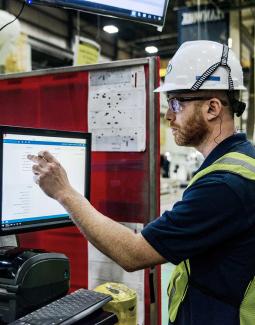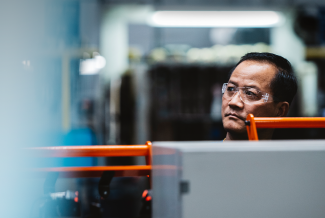

Now Available!
Get your copy of the 7th Annual State of Smart Manufacturing and hear from 300+ manufacturers in this new survey report!

Please complete the form to view
How to increase productivity, decrease scrap, and reduce inventory with MES.
Smart manufacturing begins on the shop floor. Traditional ERP systems can no longer support the needs of a modern manufacturing operation. With the right MES, you can increase process control and improve efficiencies.
Read this white paper to find out how MES can help you:
- Achieve tight integration between engineering, quality, and manufacturing.
- Easily track and control machine status, labor hours, production, and more.
- Streamline inventory processes by using integrated barcode printing and reading capabilities.
At A Glance

"A robust MES system improves management of materials, quality, scheduling, tool tracking, production, and more."
The Power of the Plant Floor
Today’s manufacturing enterprise gains a key competitive advantage by implementing an extremely strong shop-floor control system, also known as a manufacturing execution system (MES). Many ERP software companies claim to support manufacturing companies but their solutions do little more than accounting, order entry, and other office tasks. They are not suitable for use on the plant floor, and they provide little value to the manufacturing process. Many manufacturers indicate that traditional ERP software actually hinders manufacturing, rather than helps it. The key is to implement a solution that allows manufacturers to take control of the plant floor; this solution must include job/ production management, process instructions, production scheduling, ultra-detailed real-time inventory control, tool tracking, production tracking, traceability and part genealogy, labor tracking, PLC machine integration, and much more. This is what MES solutions offer, and they can be offered either as pure-play systems that connect to ERP, or in some cases fully embedded with ERP.
Baseline Capabilities
Baseline capabilities for a MES include:
- Simple, easy-to-use design for use by plant floor personnel.
- Real-time information reflecting up-to-date processes.
- Online for ease of access via a browser.
- Built-in barcode labeling.
- Built-in support for mobile/wireless handheld units.
- Built-in integration with machine PLCs.
Built-in integration with weigh scales, packaging machines, and other equipment. MESs deliver functionality supporting these capabilities in two main areas, engineering and production tracking.
Engineering
Manufacturing engineering determines product design, the parts making up a product, how those parts are assembled, and the processes required from plan to completion.
Part List
Robust shop-floor reporting must track a master list of parts, including all associated part data, such as part description, part type, and revision. This includes an easy-to-use mechanism to upload small digital photos of each part. The part list also provides links to many other areas of the system, where applicable, such as key part dates, customer part numbers, advanced product quality planning (APQP) checklist, inventory, shipment history, problem history, and so on.
Process Routings
A process routing is the series of steps required to manufacture or process a given part. This function defines those steps. It includes the operation number, operation name, approved workcenters and suppliers, crew size, weight, container type, and other key routing data.
Bill of Materials
Each manufacturing process has a distinct bill of materials (BOM) which defines the components that make up a part. A flexible BOM function offers indented BOMs, exploded BOMs, drill-down BOMs, and a variety of other methods for visualizing and editing BOMs.
Multi-Part Production
An IT system must identify and control manufacturing processes where multiple parts are produced from a single operation. This is a critical capability for stampers, multi-part die forgers, injection molders, and other manufacturing processes.
CAD Integration
Many manufacturers benefit from a special feature within their CAD system to number and name each dimension on the part drawing. Then, whenever the drawing is saved, it synchronizes the dimensions and their tolerances to the part specification list, which in turn drives the control plan, check-sheet, and data collection systems. The CAD integration subsystem saves manufacturers from having to enter dimensional data and adds a high degree of advanced integration among engineering, quality, and manufacturing.
Production Tracking
Robust production tracking provides tracking of machine production, including detailed and summarized reports. Data is more valuable when it is highly integrated with inventory, tool tracking, and scheduling.
Control Panel
Control panels offer a simple-to-use, yet powerful user interface for shop-floor personnel to track and control machine status, labor hours, production, inventory, tooling, and much more.
Workcenter Tracking
A workcenter log provides a detailed history of all events that occur at a machine, including all production, maintenance, and downtime. This function provides reports on uptime, availability, and machine efficiency. Far-reaching benefits result when integrating this function with other business processes including production tracking, inventory, labor tracking, tool-life tracking, and control plans.
Job Tracking System
This system tracks jobs and work orders within the manufacturing facility. It depends on the situation, but usually a job represents an instruction to the plant floor to produce a certain quantity of a certain part number by a specific due date. The system is the foundation for production scheduling and can be used for simple scheduling on its own.
Job Tracker
Job trackers offer a simple-to-use, yet powerful way for shop-floor personnel to retrieve instructions, track activities, and record production against jobs as they are processed.
Setup Tracking
Setup tracking provides a place to record workcenter setup times and issues, including detailed data on reasons for setup delay. This helps shorten setup times and improve setup consistency.
Production Information Visibility is a Must
In addition to IT systems covering engineering and production tracking as noted above, a robust MES system must give a manufacturer visibility and management of materials, quality, scheduling, tool tracking, and inventory management in order to track individual containers or individual parts on the plant floor. For example, full process traceability is critical in high-precision, high-liability manufacturing such as automotive or aerospace. An MES’s advanced features must automatically track the complete genealogy of all inventory containers, providing both an upstream and downstream trace, even in complex assembly and manufacturing environments. You need this to track down and isolate all parts created from a defective lot or tracking down exactly who/what/ when/where a defective part was produced.
Additional Communication Technology Needs
Other advanced technologies for plant floor control include integrated barcode printing and reading capability for inventory, gage control, time and attendance, and user log-in cards. Wireless networking, touch-screen functionality, integrated radio frequency identification (RFID), and automated notification capabilities are also key for plant floor control.
Controlling the Plant Floor is a Must
A modern, powerful, user-friendly MES is critical to meeting manufacturing needs and enabling the end-to-end visibility required to run an effective, efficient enterprise. MES in the cloud inherently offers greater connectivity to a consolidated set of data from the entire enterprise. Cloud’s digital nature enables automated processes both within and upstream of production to ensure critical data is gathered and shared to operators, plant floor managers, and corporate for insights into continuous improvement opportunities. The tracking and analysis of material and processes, combined with greater automation and connectivity delivered by a modern MES offer greater quality management, business visibility, and ultimately control of the entire enterprise.



